Slovenia’s long route to Freedom
I have 12 minutes to change to the international train from Budapest to Ljubljana in Janoshaza. It is required to have a reservation for that train and therefore tension rises when there is a 6 minute delay in Tapolca because of an oncoming train. However, the modern railcar makes up for most of the delay and we arrive in Janoshaza almost on time.
Janoshaza station has apparently already benefited from rationalization improvements. Two tracks are left, but one seems to be unused. There is a level crossing to the other one. There is a primitive shelter outside but the station building is still open and in good condition. Insidesome other passengers hide from the heat. There is no railway staff. Outside an English – German couple try to understand the announcements. We do not even discern the place names. Like myself they are on their way to Ljubljana and Venice on that international train. Of the locals, nobody seems to understand another language than Hungarian. We pass the time making jokes about German Railways. Janoshaza could be managed by Deutsche Bahn.
The international train Budapest - Ljubljana pulls into Janoshaza
Eventually the international train arrives with a delay of 45 min. It consists of old Slovenian compartment carriages with windows to be opened. In his book “Italian Ways” the British writer Tim Sparks dedicates a page to the advantage of a train with compartments as compared to the open-plan carriages preferred nowadays by railway companies. In every compartment at a certain point a conversation is bound to start. It is much easier to hide behind a screen if you sit in a separate seat of an open plan carriage without direct neighbors. In addition the compartment blocks out the noise created in the rest of the carriage. On this train I share a compartment with two Dutch girls and an American woman from New York. The girls have just finished high school and celebrate it with an interrail trip of 2,5 weeks to places like Prague, Budapest, Ljubljana and Florence. The American woman is on a two week trip to Budapest, Ljubljana and Trieste. All have booked their trains and overnight stays in advance.
After the summer one of the girls is going to study medicine. The other is taking a gap year. One of her plans is to join a volunteers group in South Africa and Mozambique. When you will have to work beyond an age of 70 before retirement it is better to start late, is her idea. Industry used to prefer starters as young as possible. What is the benefit of letting old people work longer to reach retirement when the working life is not getting longer since starters start later or take breaks? Does it make sense to replace the working time of energetic young people by worn-out and frustrated septuagenarians?
The ride on the international express from Janoshaza to Ljubljana takes more than 5 hours. In Zalaegerszeg the direction changes. In Ptuj the line crosses the Drava river. The bridge allows a glimpse of the magnificent castle above the town, the biggest in Slovenia.
Most of the line is modernized. High platforms and underpasses have replaced level crossings. The modernization is done to perfection. Lots of concrete and steel. One platform even has 2 clocks next to each other. They seem to have forgotton here that they do not rebuilt an airport without tradition.
After Zidani Most the line follows the narrow bends of the spectacular valley of the river Sava. Limestone rocks line the valley. There are pockets of neglected industrial sites, but in general there is little space for agriculture and the slopes are covered in dense deciduous forest.
In contrast to the Hungarian half of the empire the Austrian half was quite heterogeneous and consisted of seventeen historical crown lands. There was not even a generally accepted common name and therefore this part was called ‘Cisleithania’ (territory on this side of the “border river” Leitha separating Austria and Hungary which became ‘transleithania’). Next to becoming emperor in 1848, Franz Josef I also became king of Hungary, of Bohemia, Galicia. Croatia, Slavonia, Lodomeria, Ilyria, Dalmatia and Lombardy–Venetia, voivode of Serbia and Banat of Temeschwar, Duke of Bukovina, Grand Prince of Transylvania, Margrave of Moravia, Duke of Silesia, Modena, Parma, Piacenza, Carniola and Guastalla, of Auschwitz and Zator, of Teschen, Friaul, Ragusa and Zara, Prince of Trento and Brixen, Lord of Trieste, of Cattaro and the Windic March.
The terms Ilyria, Windic March, Carniola, Carinthia or Styria all somehow represented parts of today’s Slovenia. The area was important for the north-south and east-west trade routes. Access to the important and after 1868 only Austrian sea port in Trieste from the east was via Ljubljana, called Laibach in Austrian times.
Zidani Most
After the Romans, Carintian Dukes, Teutonic Knights and the Franciscans passed through the area.
Finally it was conquered from King Ottokar II of Bohemia by Rudolph of Habsburg in 1278.
Oncoming train
The area was ruled by the Habsburgs almost continuously until 1918. Only between 1809-1813 under Napoleon it was an Illyrian province of France. Although there were attacks by the Ottomans or rebellions, Slovenia and in particular Ljubljana is one of the few areas in the Balkans (although they probably don’t like to be identified with the Balkan but rather as an Alpine country) which enjoyed relative peace and continuity. Until the 20th century German was spoken by the ruling class and in the urban areas while the peasantry spoke Slovene.
The train arrives in Ljubljana half an hour late. There was no food on this international train and after I have checked into a pleasant hotel situated between the station and the center of the old town I decide to have an early dinner. Friends have sent me a long list of recommendations and it turns out that one of the restaurants is right around the corner. They place me on a big table and I spend my tasty dinner in the company of asexual and technocratic Germans and non-communicative Austrians on their way to a vacation along the Croatian coast.
The old town of Ljubljana nestles along a bend of the Ljubljanica river around the hill crowned by the castle. In total there are 28 bridges spanning the river. The most unique and famous is the triple bridge. To explain why there are three identical bridges next to each other one has to know the story of Jože Plečnik (1872-1957), Slovenia’s most famous architect.
Art Deco in Ljubljana
Plečnik was born in Ljubljana but moved to Graz and Vienna where he studied and worked under the famous Viennese art-deco architect Otto Wagner until 1900. Once a female friend asked Plečnik in a letter to marry her. He replied "I am already married to my architecture.” After returning to Ljubljana Jože Plečnik would become what Gaudi is for Barcelona
In the 16th century Carniola had embraced the reformation. However, the Habsburg emperors, as such affiliated with the pope, were eager to suppress the reformation. Religious persecution started under archduke Charles in 1564. As a reaction on the iconoclasm of the Protestants the churches were remodeled in Baroque style. The old part of town therefore was built in Austrian Baroque.
In 1895 90% of Ljubljana was destroyed by an earthquake. Big parts of the city had to be rebuilt. The city council asked Jože Plečnik to come back to Ljubljana to help rebuilding the city. Plečnik not only designed new buildings but also devised an overall layout for the city. His most famous buildings in Ljubljana were the national library, the fish market, the cemetery and the triple bridge.
There already was a bridge at the location. However, it was too narrow for the increasing amount of traffic. Instead of demolishing the old bridge to replace it with a bigger new one Plečnik proposed to built two additional new bridges copying the design of the old existing bridge. His proposal also was cheaper. By doing so Plečnik also broke with the general egocentric attitude of architects who want to add buildings according to their own design to an existing surrounding without taking into account the neighboring buildings.
Triple bridge
When rebuilding the next bridge down the river the Austrian emperor wanted to have Austrian eagles as decoration. By arguing that eagles would be more expensive, they were replaced by dragons, the symbol of Ljubljana.
Not far from the bridge is the statue of France Prešeren (1800 - 1849). He is considered to be Slovenia’s greatest poet. On the facade of an old building a bit further is the head of a woman. It represents Julija Primic, sixteen year old daughter of a rich merchant. Julija became the unfulfilled love of Prešeren’s life. Although he never married he had a partner and three children. On his deathbed he confessed that he never forgot Julija, who meanwhile had married another man. The statue is crowned by a scarcely dressed woman. When it was unveiled it raised the objections of the church: the facade of the franciscan church of the annunciation is right across the square. The problem was solved by planting a number of trees between statue and church to block the view.
Julija Primic
Other building projects in Ljubljana were met with bad fortune. Robbov vodnjak originally was built by the Italian sculptor Francesco Robba in 1751 after the example of similar fountains in Rome. However, the ship with the Carrara marble to built it sunk. The present fountain is a copy, the original is in the national museum.
A bit further on is Saint Nicholas's Cathedral. To celebrate a visit of the pope to Slovenia in 1996 the church got new brass doors with reliefs by Tone Demšar representing 1250 years of Slovene christian history. A curse pretends that it is bad luck when the sculptor puts his image on the piece of art. And indeed, the sculptor died three month after the doors were finished.
A funicular climbs up to the castle residing above town. If you had expected a romantic medieval ruin you are wrong. They have reconstructed the castle and from inside you see more concrete than original masonry. After I have looked for the exit gate for a while I climb down to the market at the base of the castle hill.
The different ethnic groups of Cisleithania were keen on independence. Attempts for further unification failed. It was difficult to keep such a heterogeneous conglomerate together. The construction of railways allowed faster communication and exchange of the different parts of the empire and in case necessary, the quick transport of troops. Already in 1849 the Südbahn linked Ljubljana to Vienna and in 1857 to Trieste. It allowed a direct rail connection to the most important Austrian port. Soon lines to Zagreb, Budapest, Pula, Rijeka and Villach followed. Many of the lines had to cross extremely difficult terrain. The crossing of the Semmering in 1854 by the Südbahn line from Ljubljana via Graz to Vienna was the first mountain railway ever built.
Steep grades and narrow curves required the development of specific engines. The chief engineers Gölsdorf, Rihosek, Steffan and Prossy of WLF and StEG, the engine factories in Vienna which built most of the Austrian engines, developed powerful engines with a characteristic, typical Austrian design. There is no place to better appreciate the development of these engines than the Slovenian Railway Museum in Ljubljana. In fact, it should be called Südbahn Museum, because nowhere so many of these engines can be seen in such a perfectly restored state.
The museum is housed in the former engine shed not far from Ljubljana’s central station. The engines are housed in a typical roundhouse. All the explanations are in Slovene, German and English.
In 1859 steam engines with three driving axles and a weight of 64 tons were revolutionary. StEG, Esslingen and Sigl built more than 200 engines of Südbahn class 29. It was one of the best and most widely spread locos of the former Austrian Südbahn-Company. 66 remained in Yugoslavia after WW I as class 124. With an age of 60 years they already were rail Methuselah's at the time. No. 718 is the oldest locomotive in the Slovene Museum collection.
In 1885 Gölsdorf developed an express train engine for the lines of the Südbahn. 12 of the class 17c were found in Maribor and 8 more in Trieste. As Yugoslav class 103 they hauled trains from Maribor to Ljubljana, Postojna, Prevalje and Zagreb. Before WW II all were scrapped. However, because of their great historical importance the museum bought No. 406 from the GKB (Graz-Köflacher Elsenbahn) where they were in service until the 1960’ies.
This little engine, SB 4.52, was built in 1880 by WLF Floridsdorf for branch lines. In order to avoid having to carry a baggage wagon on local routes, the designers Elbel and Gölsdorf designed a driver’s cab with a baggage compartment. Despite their chubby appearance, the locomotives were agile and maneuverable. The 162-001 significantly reduced travel times between Lubljana and Kamnik.
In 1884 the Emperor's and King's Austrian State Railways (kkStB) were founded. They developed three new standard locomotive classes: an express loco, a light multi-purpose loco and the heavy freight class 73, extraordinary powerful, yet simple and reliable. Until 1909 there were 453 engines built. Class 73 became the standard type of the Austrian Military Administration. She was in service on nearly all mountain lines in Old-Austria but in Slovenia not until WW l. After the war 4 engines remained in Ljubijana-Siska shed. As class JDZ 133 they served for train pick-up and shunting. This particular engine first became German 55 5737 during WW II and then ended up in Slovenia as 73.372.
After 1910 StEG developed a light tank loco of 67 ton for suburban service. With a top speed of 80 km/h and 500 HP it could also pull express trains on short distances. In Austria it was class 229. in Yugoslavia 116. She was in service everywhere in Austro-Hungarian Empire and also on Slovene lines from Ljubljana to Tarvisio, Karlovac, Vrhnika, and Koéevje.
Probably the best passenger locomotive of the former Austrian Südbahn and a milestone in locomotive construction was class 109 built after 1910. Hans Steffan and Ernst Prossy developed this elegant engine specifically for the line Ljubljana - Trieste. Her appearance was referred to as "utilitarian severe and of stark beauty.” On trials it reached a peak performance of 1547 HP and a speed of 128 km/h.
After 1920 the BBÖ built the freight engine class 81. In contrast to Gölsdorf’s highly complicated, delicate and maintenance intensive engines, his successor Rihosek developed a strong (1360 HP, robust and durable machine. After WW II 42 locos of this 120 ton behemoth remained on the lines in Yugoslavia. In Slovenia they hauled the heaviest trains on all main lines, in Istria notwithstanding their low top speed of 60 km/h occasionally even expresses.
After world war II many former German engines remained in Yugoslavia. One of them was the Prussian class G12, a heavy, very powerful freight locomotive of 140 ton built after 1919. 49 of this JZ series 36 were based in Ljubljana and Nova Gorica for heavy freight trains. With their three cylinders they developed enormous pulling power of 1540 HP but were also more complicated to maintain. The fireman had to do extremely hard work.
To a part of the roundhouse access is not permitted. Here the museum keeps their operational engines. It is a pity that they do not offer guided tours to this most interesting part of the museum. It also could increase the meager income from the few visitors to the premises.
Outside the shed the museum keeps some more or less derelict engines.
After 1911 the kkStB built a five coupled freight engine for their mountain lines. Different versions were built even after WW I. After the collapse of the k&k empire the engines ended up in Poland, Italy, Czechoslovakia, Romania, Yugoslavia and even Iran. In Austria the engines were used until 1968. 28 029 was built as Austrian 80 120 in 1922.
During the second world war the German Reichsbahn built more than 7794 engines of class 52. They were simple but powerful engines to be used during the war with little maintenance. After the war they ended up in most of the continental European countries. In some they were used until the 1990’ies. 350 engines remained in post war Yugoslavia. Several are still today, in 2024, in use in the coal mines in Tuzla, Bosnia-Herzegovina. Two are preserved in the Ljubljana museum, 33 339 (52 2377) and 33 253 (52 3417). Another one is operational and resides in the closed parts of the shed.
After 1929 the German locomotive company Borsig built 30 engines of the type 06 for the Yugoslav railways. With a top speed of 85 km/h the engines were used for freight and passenger trains in mountainous terrain. Here they even pulled prestigious trains like the Orient and Tauern express. Some of the engines were used until the 1970’ies. The museum in Ljubljana preserves three of the engines. 06 016 is used as a source of spare parts for her operational sister 06 018, which is hidden in the closed parts of the roundhouse.
For minor branch lines in the k&k empire numerous railways of a gauge of 760 mm were built. The line Poljéane - Slovenske Konjice (Pöltschach – Gonobitz) built by the Steiermarkische Landesbahnen (StmLB) in 1892 crossed the present border between Austria and Slovenia. Krauss Locomotive Factory in Linz, specialised in narrow gauge engines, manufactured four identical locos of 12 ton and 78 HP, No. 1 - Meran, No. 2 - Stainz, No. 3 - Gonobitz and No. 4 - Heiligengeist. No. 3 and No. 4 came on the Konjice line while the other 2 came to the line Preding-Wieselsdorf - Stainz in Austria. No. 3, whose name had been translated to Konjice after WW 1, was preserved because she was used by the Jesenice Iron Works. Her sister Stainz, No. 2, is still pulling nostalgic trains in Austria.
Very special were the rack narrow gauge lines across the Ivanpass and the Komarpass in Bosnia Herzegowina. From 1894 until 1919 the Bosnian railways BHStB ordered 38 rack engines with a gauge of 760 mm. The engines were used until the lines were closed in 1975. Engine 97 028 is displayed with a typical narrow gauge train of the time.
The exterior of the museum also displays other interesting artifacts of the classical time of steam engines. There are two elevators to supply the engines with coal and there is a crane for repairs.
Across the terrain there are various carriages in different states of decomposition. Usually they are the most rewarding photographic subjects of each museum. And most probable to disappear.
In the course of the 19th century, during the resorgimento, the Habsburg empire lost most of their Italian possessions. The border with Italy was now very close to Trieste, the only Austrian port in the Mediterranean. In 1906 the k&k Staatsbahn built the spectacular railway from Jesenice via Bohinjka Bistrica, Gorica and Opcine to Trieste.
There are a couple of direct trains from Ljubljana to Trieste but I did not want to miss the opportunity to see this spectacular mountain railway. After the brilliant breakfast offered by the hotel and a fairwell present of a couple of bottles of Slovenian made Cola and water I walk to the station to take a train to Jesenice, continue along the Wocheinerbahn to Gorica and from there to Sezana. There I would catch the direct train coming from Ljubljana.
At platform 4 of the station in Ljubljana a crowd is already expecting the train from Zagreb, which will continue to Jesenice and Villach. Amongst them also the two Dutch girls whom I met two days ago on the train from Budapest. The train is announced on the platform board with the scheduled departure time of 9.24 am. Thefrequent announcements on the station intercom are in Slovene and incomprehensible for most of us. We assume that they do not concern us since the arrival of an international train would be announced in English for sure.
Travel how it used to be
At 9.20 an EMU pulls in. People get off and a part of the waiting crowd pulls their roller cases through the open doors inside. However, this cannot be the train to Jesenice. First of all it did not arrive from Zagreb. Second, it does not look like international trains usually look like. Those who boarded come to the same conclusion and after a while the train disappears, empty. At about the same time the announcement of the international train to Villach disappears from the announcement board.
Meanwhile, on the other track of the platform, the local train to Jesenice scheduled to depart at 10 am has been provided. If on time it will arrive in Jesenice at 11.06 am, early enough for me to catch the connecting train to Gorizia at 11.15 am. Some of the travelers who have given up on the international train start boarding the local train.
Slowly the Dutch girls get nervous. They have a whole selection of connecting trains booked to go via Villach and Venice to Florence today. An Austrian guy waiting with us shows us his Austrian app. It displays in real time where the trains are. Our international train should shortly arrive in Ljubljana.
Indeed it pulls in after a couple of minutes and also reappears on the announcement board. Regardless the number of waiting people there is enough space for everybody and I get a comfortable window seat. The train leaves Ljubljana with a delay of 25 minutes.
The tourists board the wrong train
In Lesce Bled a Dutch cyclist gets on with his bike. He has done a tour from Austria via Italy to Slovenia and has no guts to do the trip across the Alps again. On a Slovenian train it is no problem to just put the bicycle into the space behind the entrance doors. In Germany this would result in an outcry of the train manager about safety and blocked emergency exits. Which of course are needed much more frequently on a German train.
The first thing I see after arrival in Jesenice is a group of border guards surrounding an immigrant. At the other platform announced for the train to Gorica a Graffiti covered DMU is already waiting. However, the conductor, in perfect English, does not allow anybody to get on. Another train will come, will be coupled to this one and we will all have to get on that second train.
The scheduled departure time of 11.15 passes and no train arrives. In the meanwhile I can observe my surroundings. Jesenice is a big station with an attractive, neglected building in modernist style of white marble and hexagonal windows built in 1953-1954. In front of me two water cranes for supplying steam engines with water are still in decent state. From time to time there are steam specials on the line to Gorica. At the end of the platform an old, boarded up signpost out of use.
Trains to Austria change engine before they enter the 7900 m Karawanken tunnel. I observe a train coming from Austria. A Slovenian engine takes off the two Austrian engines, brings them to another track and gives them a good push so that they roll to the other end of the station. Slovenian railways use DC electricity supply not compatible with the Austria engines.
Meanwhile the sizable crowd waiting on the platform for the train to Gorizia is getting a bit restless. A wailing mentally disabled woman has attached herself to me and points nervously at the train we are not allowed to board. From time to time she points at her head to indicate that something is wrong there. I approach the conductor to tell him that she might need some help but he replies that she is a regular here and there is no problem.
Finally another two carriage DMU arrives, couples to the one already there and we depart for the 2 hour trip to Nova Gorica, 89.1 km away.
The line between Jesenice and Trieste via Gorica was opened by Arch duke Franz Ferdinand in 1906. It was part of a new rail corridor to link southern Germany and Austria to the port of Trieste by crossing the Julian Alps The construction of the line involved the building of numerous bridges and tunnels. The longest is the 6327 m Bohinj Tunnel. The Solkan Bridge with its 85 m arch over the Soča River has the longest stone railway arch in the world.
Before the first world war the line saw express trains which even had panoramic cars from the canadian pacific railway. In the first world war the area became the theater of the Isonzo front. In vain the Italians launched 12 attacks to invade into Austrian territory. All the Austrian supplies were brought to the scene on the Wocheiner railway. During a retreat in the course of the 6th battle of the Isonzo the Austrian army blew up the arch of the Solkan Bridge just to rebuilt it provisionally a short while afterwards when the terrain was reconquered.
The line very much represents the different twists of politics and history in this area. After the first world war the first Yugoslav Republic was formed. The railway was now half owned by Yugoslavia and by Italy. The border was at the Bohinj tunnel. The importance was widely reduced since the port of Trieste had lost its Austrian back country.
In 1945 Tito proclaimed the communist Yugoslav republic with socialist characteristics. The border changed so that most of the railway now was on Yugoslav territory. However, since the terminus was still in Trieste, which remained Italian, a bypass was built from Kreplje to Sežana to obtain a connection to the previous line from Ljubljana and on to Istria without passing through Italy when coming from Gorizia.
The line first follows the valley of the Save on the southeastern border of the Triglav National Park. After the second stop the train disappears in a tunnel right at the end of a first bridge across a gorge. Soon afterwards it passes through the station of Bled Jezero right at the lake which is one of the most famous sights of Slovenia. Most of the tourists get on or off here. The valley of the Save gets narrower until the line passes the water shed to the Adria above the Bohinj Tunnel. The tunnel is also used for shuttling cars from one side of the mountains to the other. After the tunnel the line descends following the valleys of Idrijca and Soca which is dammed to a reservoir with spectacular turquoise waters before reaching the station of Canal. Groups of canoes look like toys from the position of the train above.
When this line was still operated with steam engines JZ class 17 were used. Originally constructed in 1914/15 for the suburban traffic of Budapest they came to Slovenia after 1928 and
served till the end of the steam era on lines like Jesenice – Planica or Jesenice - Nova Gorica - Seiana. Notwithstanding their undersized boiler it was an excellent engine much loved by personnel.
After 1945 Nova Gorica became a border station. While the town Gorizia is in Italy the station was in Yugoslavia. Consequently, Italy built a new station and Yugoslavia a new town. When our train arrives it has to stop at a provisional platform because the enormous station is renovated. Outside, a display of photos and a concrete line show where the former border fence and present open border is located. A bit down the street the former border control station is still visible.
In 1990 a referendum was held for independence of Slovenia from the rest of Yugoslavia. More than 90 % of the population participated and 95 % voted for independence. The result was a 10 days war. The guide of the free tour I take in Lljubljana tells us that therefore she spent her 3rd birthday in a bomb shelter. Since Croatia pulled out as well the war stopped soon.
The foundation of the former border fence
The breaking apart of Yugoslavia in different independent states changed the traffic situation. Suddenly some railway lines were interrupted by the new borders while other lines became isolated. Koper became the main Slovenian sea port and the importance of Trieste as a port increased since it regained its backcountry. However, the consequences for the construction or renovation of railways are always very slow. It is sure that the traffic on the Wocheiner railway will increase. Already now the train is well used by tourists with or without bicycles. However, while a hundred years ago the lines were upgraded or built in preparation for the future today there only is a very slow reaction following a rising demand.
I have a stopover of more than an hour in Nova Gorica to take the connecting train to Sezana. After I have found my way around the fences protecting the construction site from intruders I find a bar at the end of the station building. A tattooed red haired girl in a tiny top and shorts tries to keep a cool head facing a crowd of thirsty builders who have invaded her bar. It seems to be the only cool place in the surroundings. Californication by the Red Hot Chili Peppers is blasting from the speakers. An American family is passing through on a rail trip from Italy to Greece. The father tells her that he had attended a concert of the band. Do we need more symbols for how times change without reason?
Arrival in Sezana
The direct rail connection between the Slovenian station of Nova Gorica and Gorizia Centrale in Italy, from where a train would regularly and quickly depart for Trieste, is still not rebuilt. I take the railcar from Nova Gorica to Sezana. It climbs up a slope into a wall of black clouds of an approaching thunderstorm. The hill of the Kostanjevica monastery is crossed in a short tunnel and after the climb the train follows the Vipava valley.
In Sezana I have another stopover to wait for the train from Ljubljana to Trieste. It is late. There is lots of freight traffic on this line. The descent into Trieste is spectacular. From the height of the Karst Plateau of 300 m at Sezana the train has to get down to sea level in a wide curve. The Mediterranean sea pops up to the right in the evening sun.
Today all dreams are allowed
Tomorrow is another day
Sources:
Railway museum Ljubljana, Information panels
Tim Parks, Italian ways, Random House, 2013
Link to previous post:
Served breakfeat in Hotel Central in Ljubljana

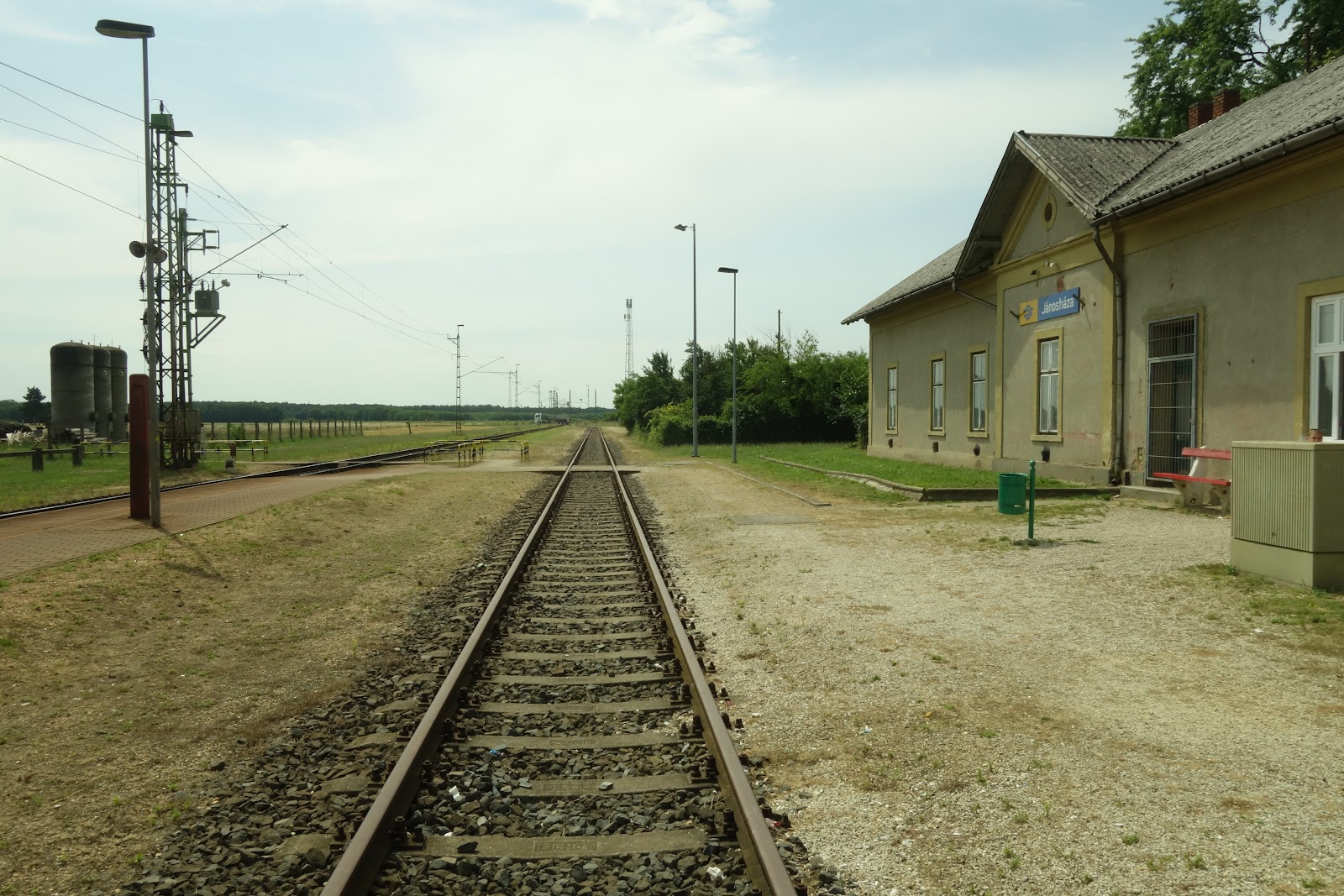

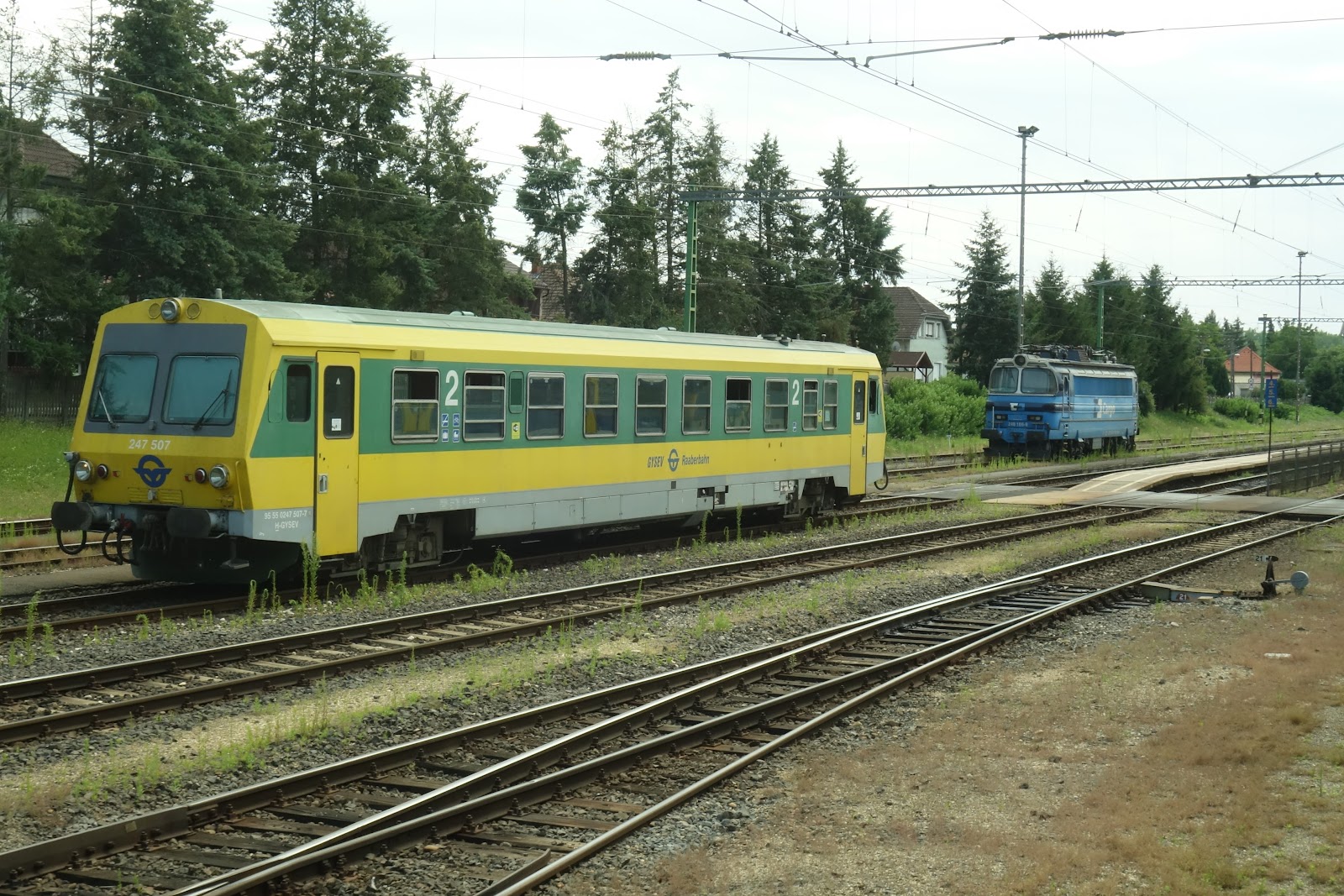


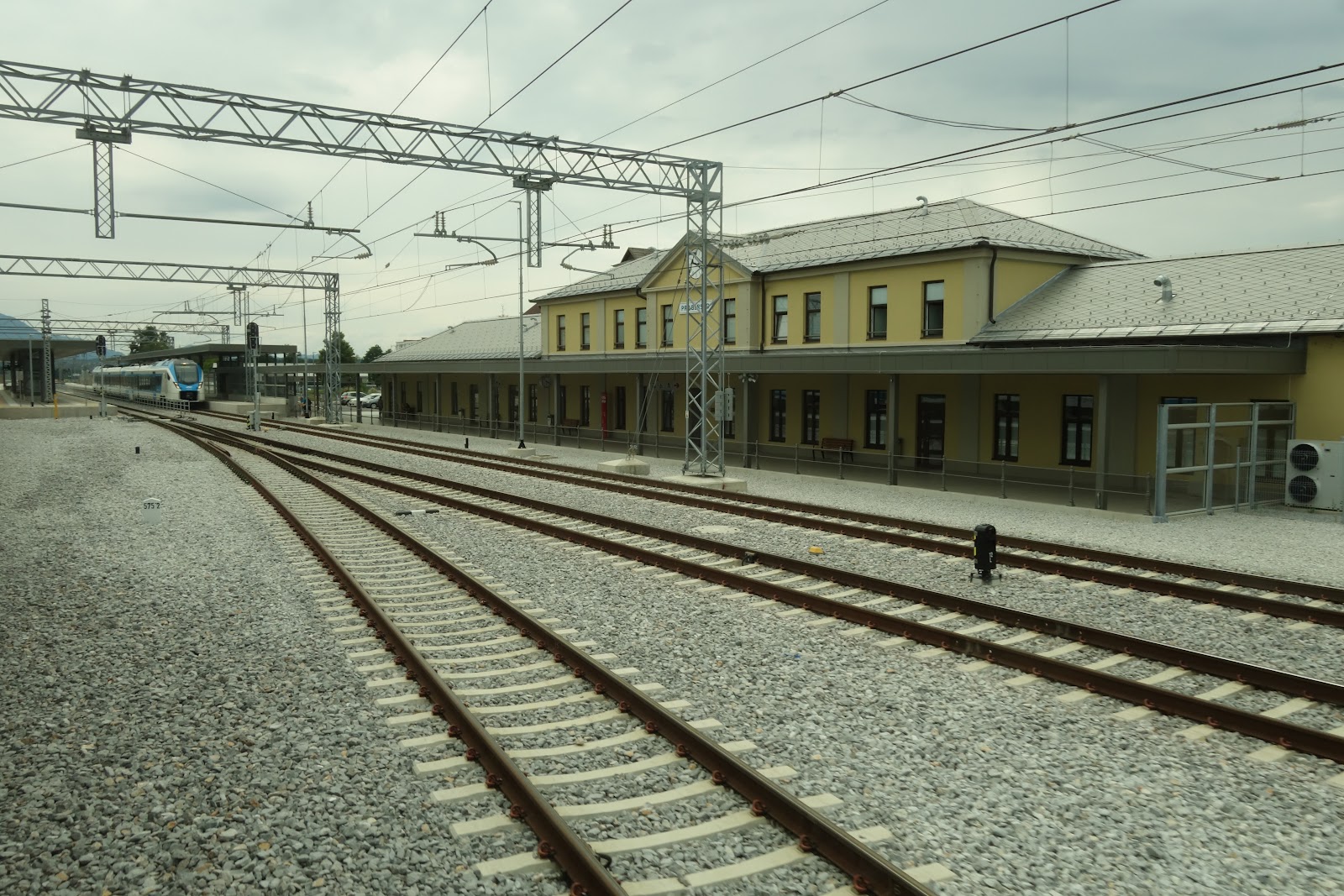

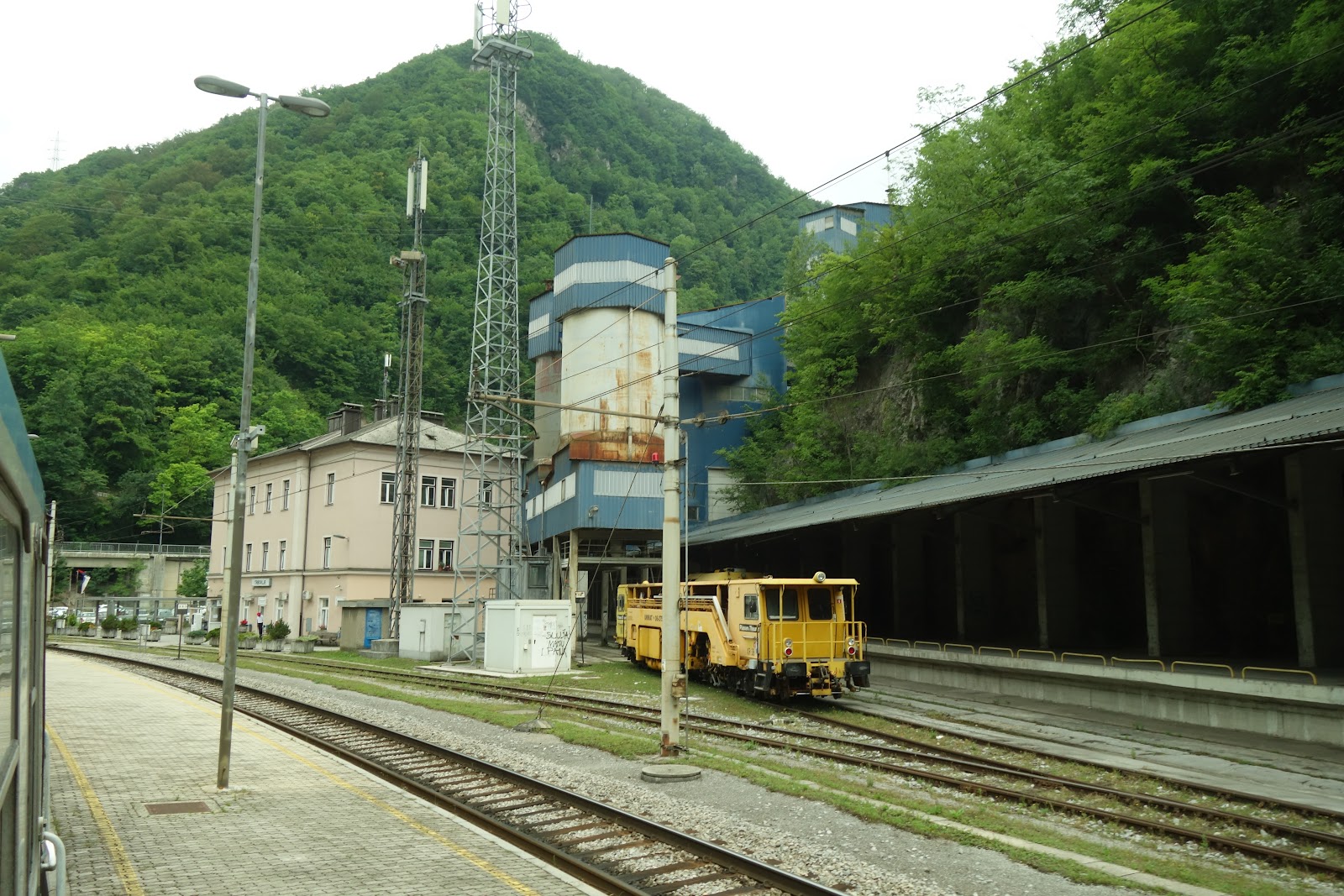

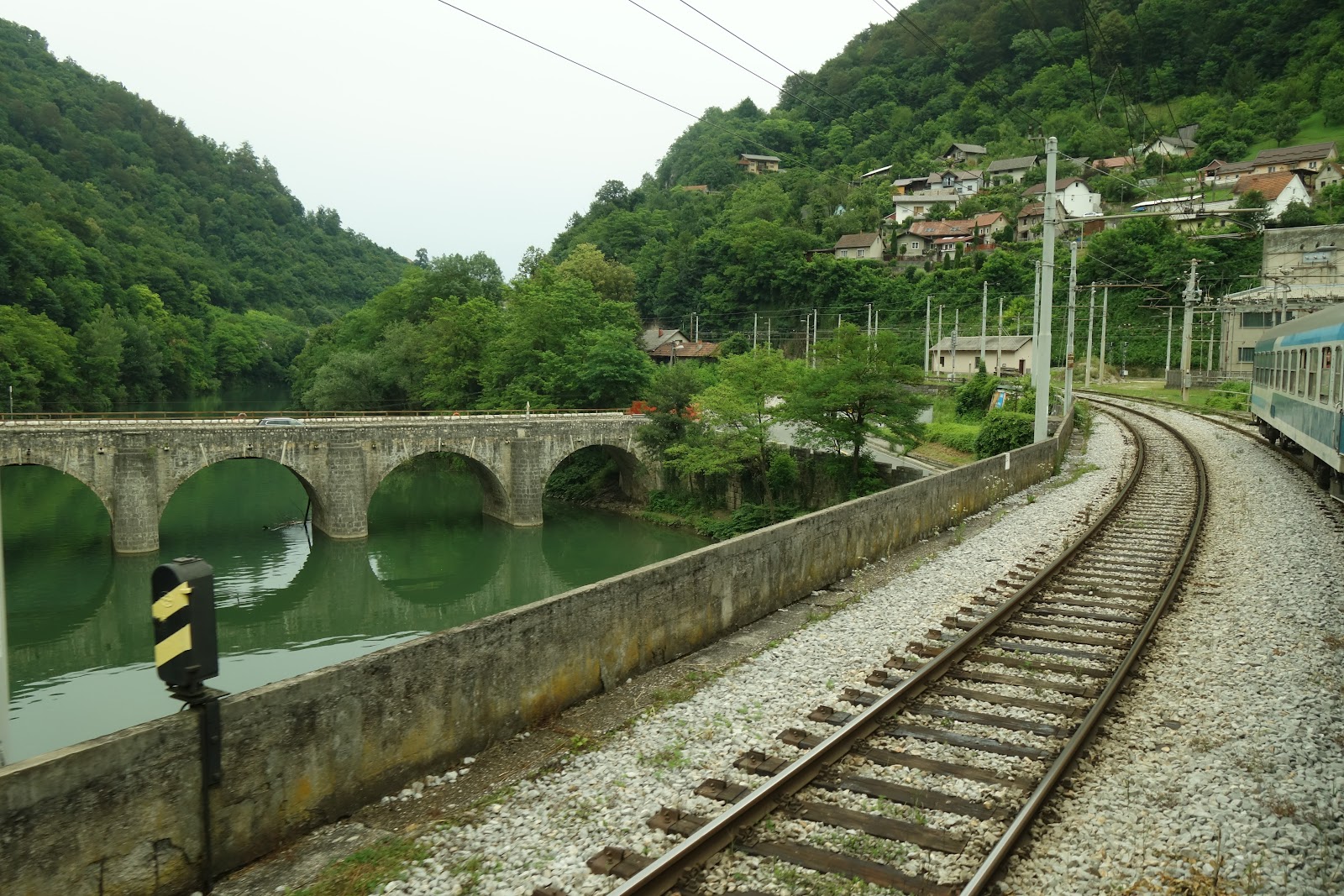

























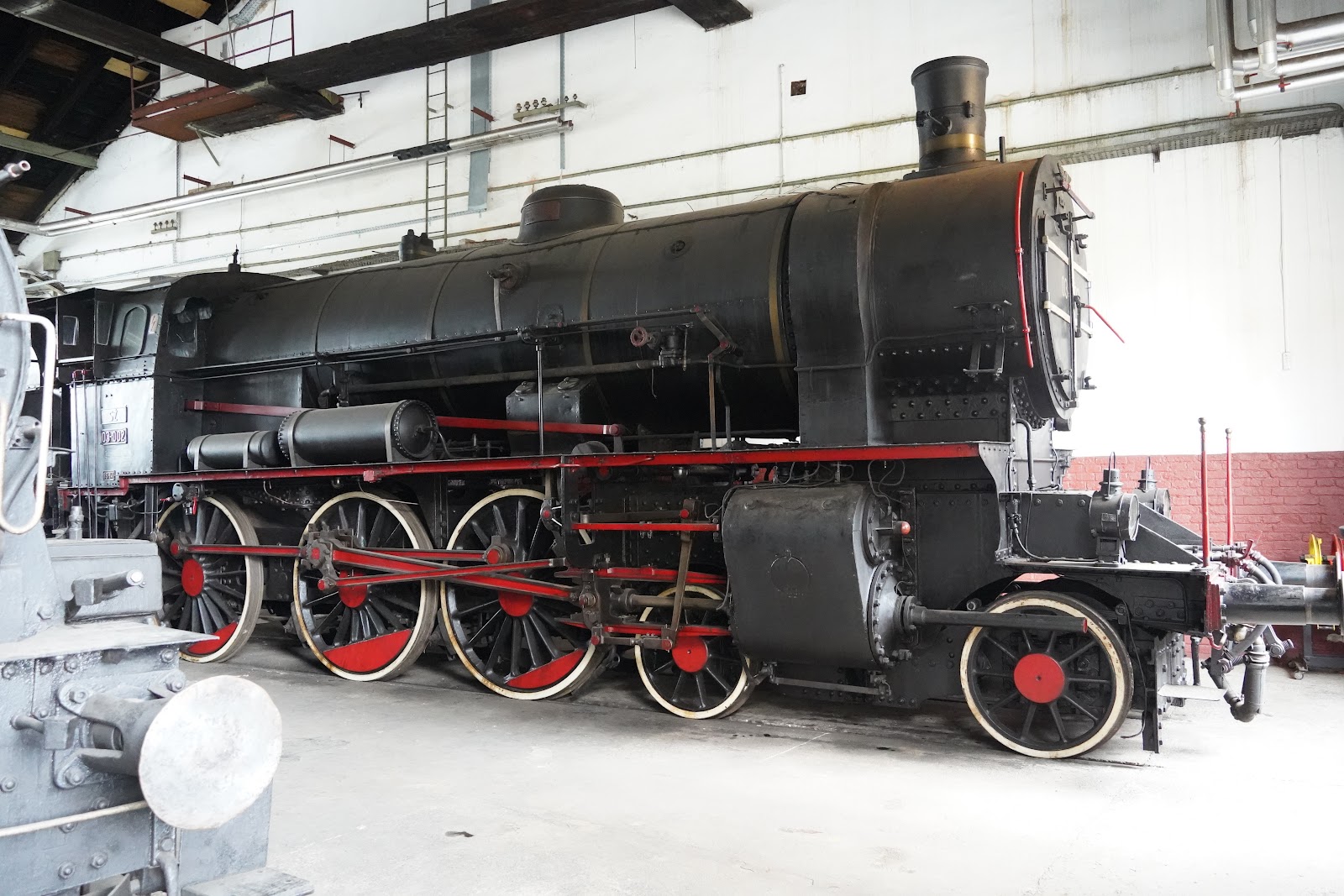




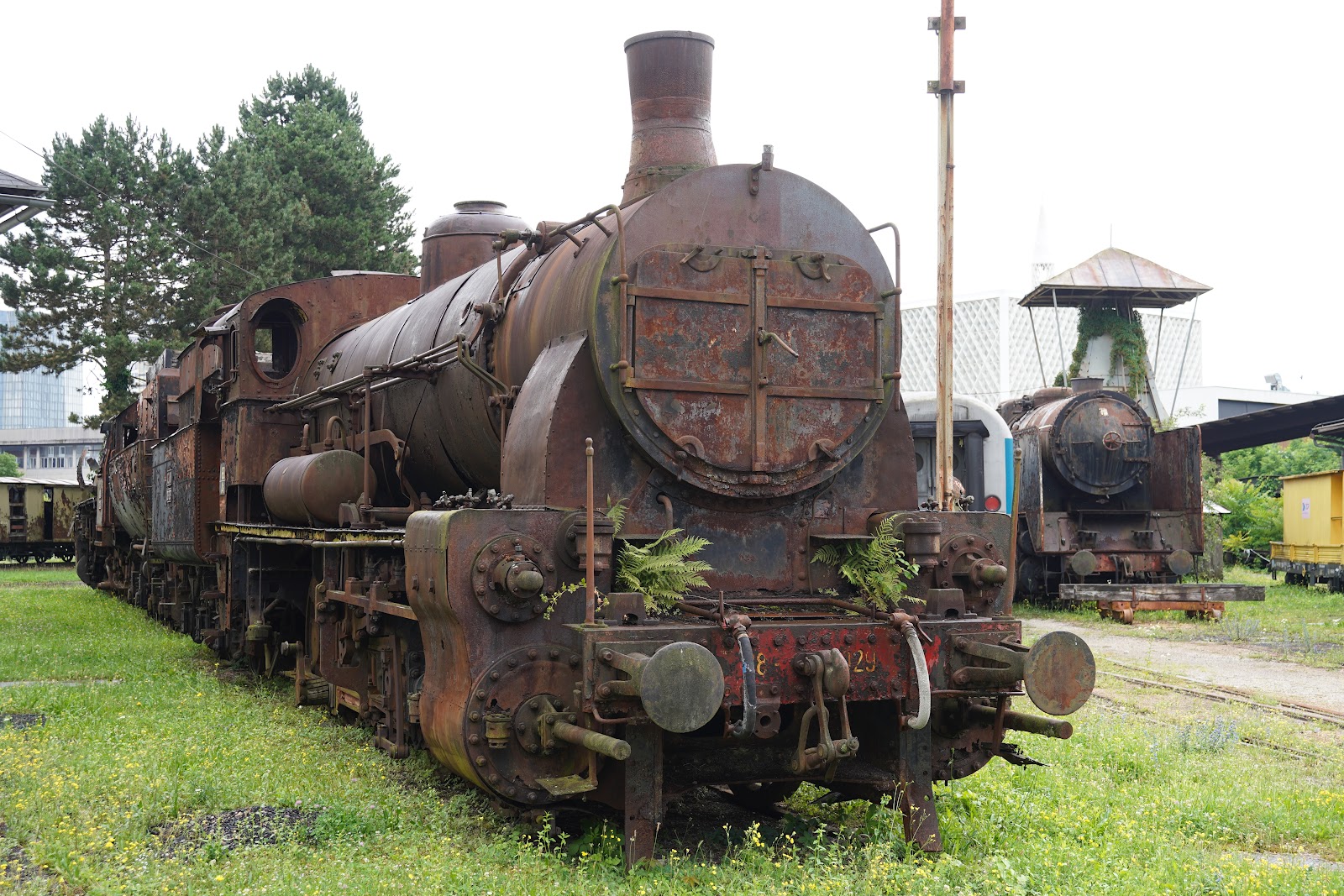






















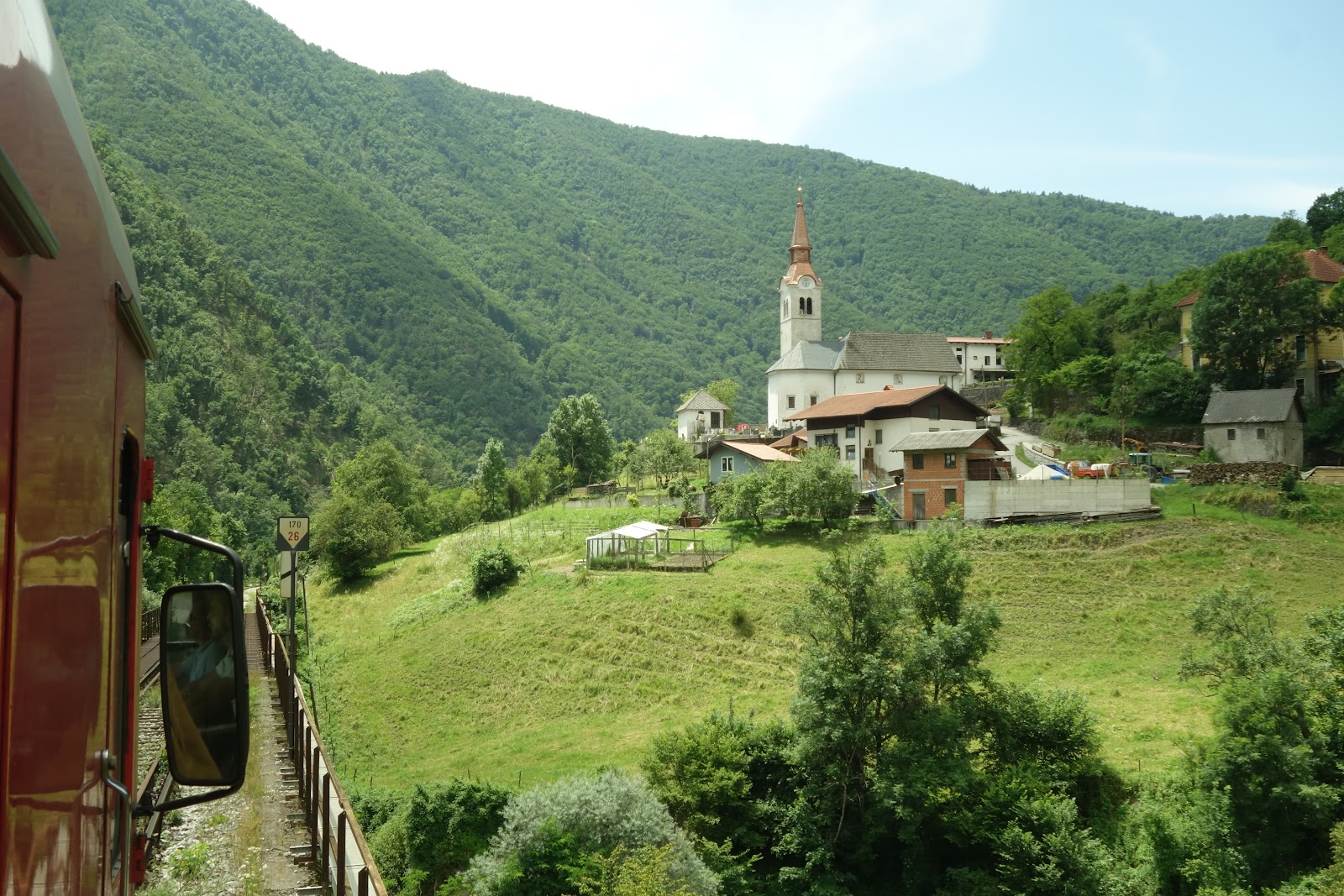








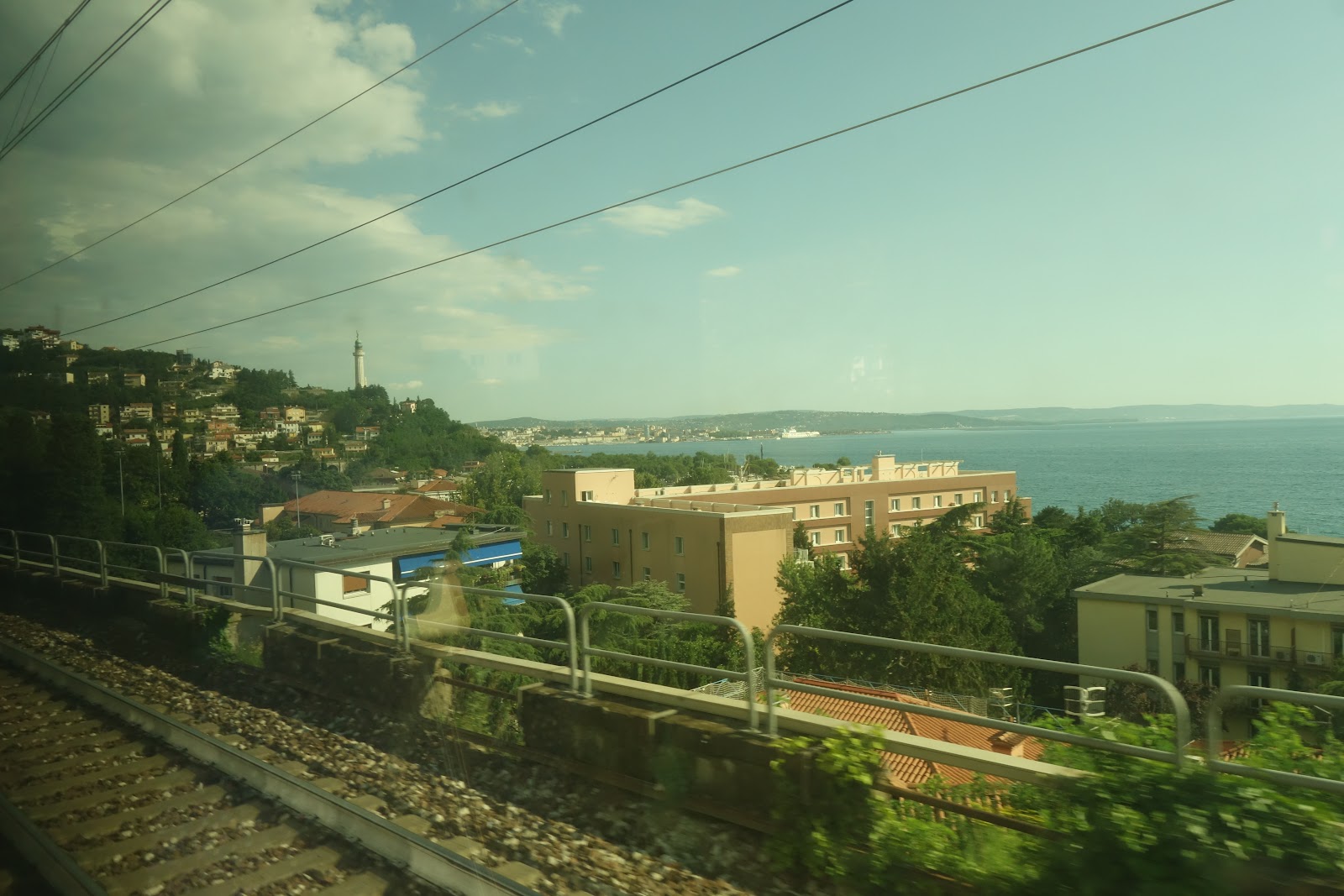


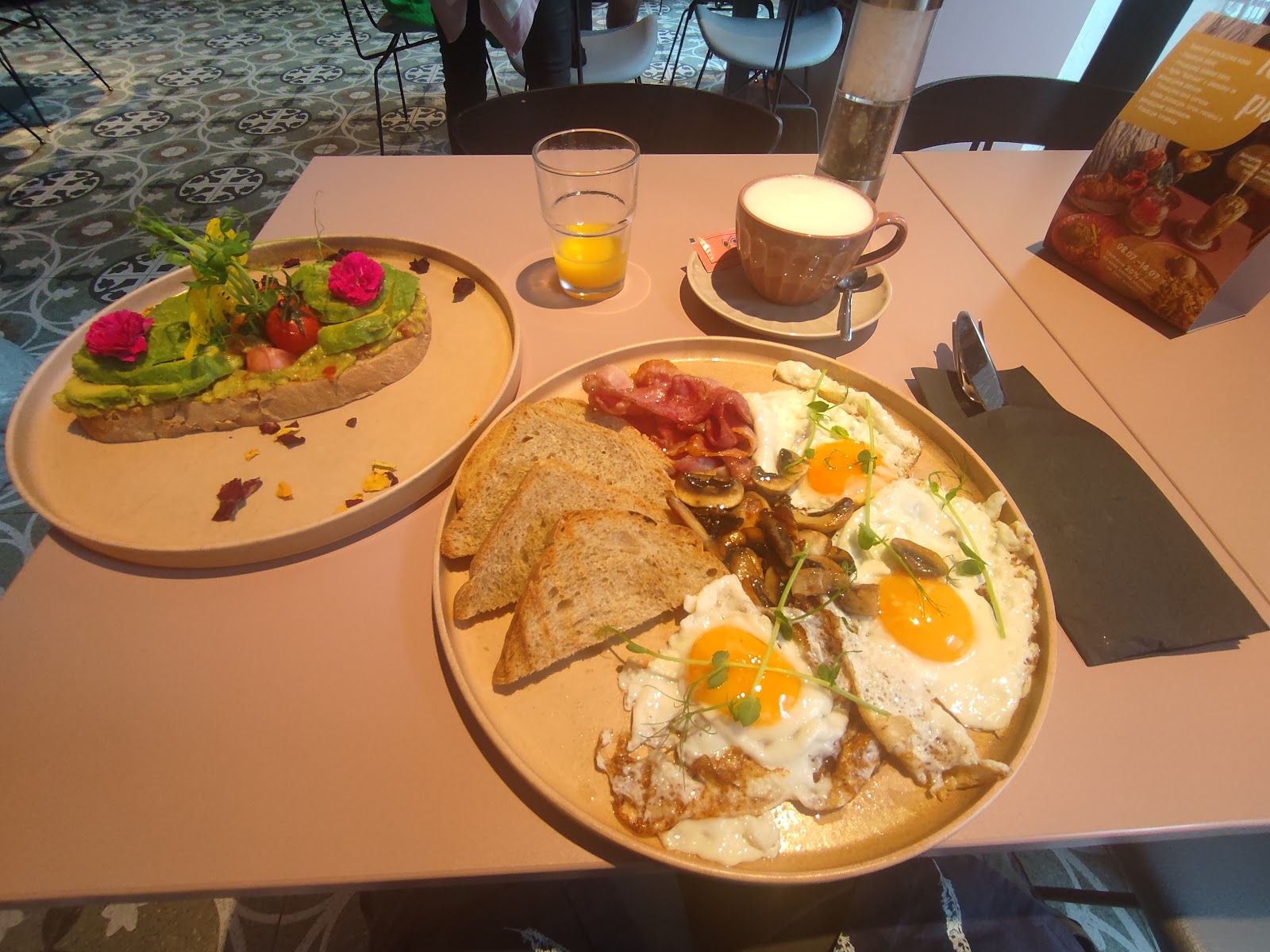
No comments:
Post a Comment